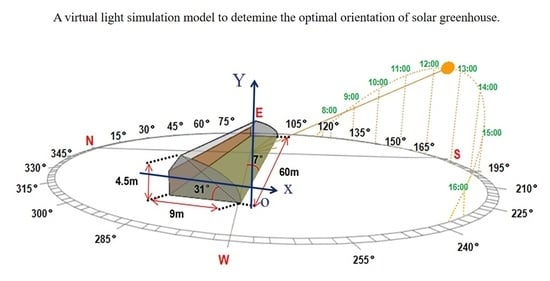Determination of the Optimal Orientation of Chinese Solar Greenhouses Using 3D Light Environment Simulations
Abstract
:1. Introduction
2. Materials and Methods
2.1. Construction of a Virtual Greenhouse
2.2. Description of the Solar Radiation Model
2.3. Validation of Model
3. Results
3.1. Interception of Solar Energy on Lighting Roof of CSG with Different Orientations
3.2. Interception of Solar Energy by CSG Maintenance Structures with Different Orientations
3.3. Interception of Solar Energy on Crops of CSG with Different Orientations
3.4. Optimal CSG Orientation in Different Areas
4. Discussion
5. Conclusions
Author Contributions
Funding
Data Availability Statement
Conflicts of Interest
References
- Sahdev, R.K.; Kumar, M.; Dhingra, A.K. A comprehensive review of greenhouse shapes and its applications. Front. Energy 2019, 13, 427–438. [Google Scholar] [CrossRef]
- Yildirim, N.; Bilir, L. Evaluation of a hybrid system for a nearly zero energy greenhouse. Energy Convers. Manag. 2017, 148, 1278–1290. [Google Scholar] [CrossRef]
- Ezzaeri, K.; Fatnassi, H.; Wifaya, A.; Bazgaou, A.; Aharoune, A.; Poncet, C.; Bekkaoui, A.; Bouirden, L. Performance of photovoltaic canarian greenhouse: A comparison study between summer and winter seasons. Sol. Energy 2020, 198, 275–282. [Google Scholar] [CrossRef]
- Chargui, R.; Sammouda, H. Effects of different collector’s area on the coupling of a thermosiphon collector and a single zone. Energy Convers. Manag. 2014, 77, 356–368. [Google Scholar] [CrossRef]
- Perea-Moreno, A.J.; Juaidi, A.; Manzano-Agugliaro, F. Solar greenhouse dryer system for wood chips improvement as biofuel. J. Clean. Prod. 2016, 135, 1233–1241. [Google Scholar] [CrossRef]
- El-Maghlany, W.M.; Teamah, M.A.; Tanaka, H. Optimum design and orientation of the greenhouses for maximum capture of solar energy in North Tropical Region. Energy Convers. Manag. 2015, 105, 1096–1104. [Google Scholar] [CrossRef]
- Dragićević, S.M. Determining the optimum orientation of a greenhouse on the basis of the total solar radiation availability. Therm. Sci. 2011, 15, 215–221. [Google Scholar] [CrossRef]
- Papadakis, G.; Manolakos, D.; Kyritsis, S. Solar radiation transmissivity of a single-span greenhouse through measurements on scale models. J. Agric. Eng. Res. 1998, 71, 331–338. [Google Scholar] [CrossRef]
- Zhang, X.; Lv, J.; Xie, J.; Yu, J.; Zhang, J.; Tang, C.; Li, J.; He, Z.; Wang, C. Solar radiation allocation and spatial distribution in Chinese solar greenhouses: Model development and application. Energies 2020, 13, 1108. [Google Scholar] [CrossRef] [Green Version]
- Tong, G.; Christopher, D.M.; Li, B. Numerical modelling of temperature variations in a Chinese solar greenhouse. Comput. Electron. Agric. 2009, 68, 129–139. [Google Scholar] [CrossRef]
- Chen, C.; Ling, H.; Zhai, Z.J.; Li, Y.; Yang, F.; Han, F.; Wei, S. Thermal performance of an active-passive ventilation wall with phase change material in solar greenhouses. Appl. Energy 2018, 216, 602–612. [Google Scholar] [CrossRef]
- Choab, N.; Allouhi, A.; El Maakoul, A.; Kousksou, T.; Saadeddine, S.; Jamil, A. Review on greenhouse microclimate and application: Design parameters, thermal modeling and simulation, climate controlling technologies. Sol. Energy 2019, 191, 109–137. [Google Scholar] [CrossRef]
- Esmaeli, H.; Roshandel, R. Optimal design for solar greenhouses based on climate conditions. Renew. Energy 2020, 145, 1255–1265. [Google Scholar] [CrossRef]
- Shin, J.; Hwang, I.; Kim, D.; Moon, T.; Kim, J.; Kang, W.H.; Son, J.E. Evaluation of the light profile and carbon assimilation of tomato plants in greenhouses with respect to film diffuseness and regional solar radiation using ray-tracing simulation. Agric. For. Meteorol. 2021, 296, 108219. [Google Scholar] [CrossRef]
- Wu, G.; Yang, Q.; Fang, H.; Zhang, Y.; Zheng, H.; Zhu, Z.; Feng, C. Photothermal/day lighting performance analysis of a multifunctional solid compound parabolic concentrator for an active solar greenhouse roof. Sol. Energy 2019, 180, 92–103. [Google Scholar] [CrossRef]
- Xu, D.; Li, Y.; Zhang, Y.; Xu, H.; Li, T.; Liu, X. Effects of orientation and structure on solar radiation interception in Chinese solar greenhouse. PLoS ONE 2020, 15, e0242002. [Google Scholar] [CrossRef]
- Chen, C.; Li, Y.; Li, N.; Wei, S.; Yang, F.; Ling, H.; Yu, N.; Han, F. A computational model to determine the optimal orientation for solar greenhouses located at different latitudes in China. Sol. Energy 2018, 165, 19–26. [Google Scholar] [CrossRef]
- Cao, W.; Li, Y.; Bai, Y. Relationship between Azimuth Angle of Solar Greenhouse and inside Temperature. J. Agric. Mech. Res. 2009, 31, 184–189. (In Chinese) [Google Scholar]
- Ahamed, M.S.; Guo, H.; Tanino, K. Modeling heating demands in a Chinese-style solar greenhouse using the transient building energy simulation model TRNSYS. J. Build. Eng. 2020, 29, 101114. [Google Scholar] [CrossRef]
- Yang, W.; Ma, C. Simulation Study on the Effect of Greenhouse Azimuth on Light Environment of Sunlight Greenhouse. North. Hortic. 2016, 19, 52–54. (In Chinese) [Google Scholar]
- Marien, H.; Coussement, J.R.; Steppe, K. Quantifying the importance of a realistic tomato (Solanum lycopersicum) leaflet shape for 3-D light modelling. Ann. Bot. 2020, 126, 661–670. [Google Scholar] [CrossRef] [Green Version]
- Kniemeyer, O. Design and Implementation of a Graph Grammar Based Language for Functional-Structural Plant Modelling. Ph.D. Thesis, BTU Cottbus, Cottbus, Germany, 2008. Available online: http://nbnresolving.de/urn/resolver.pl?urn=urn:nbn:de:kobv:co1-opus-5937 (accessed on 2 February 2022).
- Kniemeyer, O. Rule-based Modelling with the XL/GroIMP Software. In Proceedings of the 6th German Workshop on Artificial Life, Bamberg, Germany, 14–16 April 2004; Schaub, H., Detje, F., Bruggemann, U., Eds.; AKA Akademische Verlagsgesellschaft: Berlin, Germany, 2004; pp. 56–65. [Google Scholar]
- Hemmerling, R.; Kniemeyer, O.; Lanwert, D.; Kurth, W.; Buck-Sorlin, G. The rule-based language XL and the modelling environment GroIMP illustrated with simulated tree competition. Funct. Plant Biol. 2008, 35, 739–750. [Google Scholar] [CrossRef] [PubMed]
- Sarlikioti, V.; De Visser, P.H.B.; Marcelis, L.F.M. Exploring the spatial distribution of light interception and photosynthesis of canopies by means of a functionalstructural plant model. Ann. Bot. 2011, 107, 875–883. [Google Scholar] [CrossRef] [PubMed] [Green Version]
- Schmidt, D.; Kahlen, K. Towards more realistic leaf shapes in functional-structural plant models. Symmetry 2018, 10, 278. [Google Scholar] [CrossRef] [Green Version]
- Phong, B.T. Graphics and Illumination for Computer Generated Pictures. Commun. ACM 1975, 18, 311–317. [Google Scholar] [CrossRef] [Green Version]
- Kalaitzoglou, P.; Van Ieperen, W.; Harbinson, J.; Van Der Meer, M.; Martinakos, S.; Weerheim, K.; Nicole, C.C.S.; Marcelis, L.F.M. Effects of continuous or end-of-day far-red light on tomato plant growth, morphology, light absorption, and fruit production. Front. Plant Sci. 2019, 10, 322. [Google Scholar] [CrossRef] [Green Version]
- Evers, J.B.; Vos, J.; Yin, X.; Romero, P.; Van Der Putten, P.E.L.; Struik, P.C. Simulation of wheat growth and development based on organ-level photosynthesis and assimilate allocation. J. Exp. Bot. 2010, 61, 2203–2216. [Google Scholar] [CrossRef] [Green Version]
- Buck-Sorlin, G.H.; De Visser, P.H.B.; Henke, M.; Sarlikioti, V.; Van Der Heijden, G.W.A.M.; Marcelis, L.F.M.; Vos, J. Towards a functionalstructural plant model of cut-rose: Simulation of light environment, light absorption, photosynthesis and interference with the plant structure. Ann. Bot. 2011, 108, 1121–1134. [Google Scholar] [CrossRef]
- De Visser, P.H.B.; Buck-Sorlin, G.H.; Van Der Heijden, G.W.A.M.; Marcelis, L.F.M. A 3D model of illumination, light distribution and crop photosynthesis to simulate lighting strategies in greenhouses. Acta Hortic. 2012, 956, 195–200. [Google Scholar] [CrossRef] [Green Version]
- Spitters, C.J.T. Separating the diffuse and direct component of global radiation and its implications for modeling canopy photosynthesis Part II. Calculation of canopy photosynthesis. Agric. For. Meteorol. 1986, 38, 231–242. [Google Scholar] [CrossRef]
- De Visser, P.H.B.; Buck-Sorlin, G.H.; Van Der Heijden, G.W.A.M. Optimizing illumination in the greenhouse using a 3D model of tomato and a ray tracer. Front. Plant Sci. 2014, 5, 48. [Google Scholar] [CrossRef] [Green Version]
- Henke, M.; Buck-Sorlin, G.H. Using a full spectral raytracer for calculating light microclimate in functional-structural plant modelling. Comput. Inform. 2017, 36, 1492–1522. [Google Scholar] [CrossRef]
- Zhang, Y.; Henke, M.; Li, Y.; Yue, X.; Xu, D.; Liu, X.; Li, T. High resolution 3D simulation of light climate and thermal performance of a solar greenhouse model under tomato canopy structure. Renew. Energy 2020, 160, 730–745. [Google Scholar] [CrossRef]
- Zheng, L.; Zhang, Q.; Zheng, K.; Zhao, S.; Wang, P.; Cheng, J.; Zhang, X.; Chen, X. Effects of diffuse light on microclimate of solar greenhouse, and photosynthesis and yield of greenhouse-grown tomatoes. HortScience 2020, 55, 1605–1613. [Google Scholar] [CrossRef]
- Sarlikioti, V.; De Visser, P.H.B.; Buck-Sorlin, G.H.; Marcelis, L.F.M. How plant architecture affects light absorption and photosynthesis in tomato: Towards an ideotype for plant architecture using a functionalstructural plant model. Ann. Bot. 2011, 108, 1065–1073. [Google Scholar] [CrossRef] [Green Version]
- Kim, D.; Kang, W.H.; Hwang, I.; Kim, J.; Kim, J.H.; Park, K.S.; Son, J.E. Use of structurally-accurate 3D plant models for estimating light interception and photosynthesis of sweet pepper (Capsicum annuum) plants. Comput. Electron. Agric. 2020, 177, 105689. [Google Scholar] [CrossRef]
- Xu, L.; Henke, M.; Zhu, J.; Kurth, W.; Buck-Sorlin, G.H. A functionalstructural model of rice linking quantitative genetic information with morphological development and physiological processes. Ann. Bot. 2011, 107, 817–828. [Google Scholar] [CrossRef] [Green Version]
- Chéné, Y.; Rousseau, D.; Lucidarme, P.; Bertheloot, J.; Caffier, V.; Morel, P.; Belin, É.; Chapeau-Blondeau, F. On the use of depth camera for 3D phenotyping of entire plants. Comput. Electron. Agric. 2012, 82, 122–127. [Google Scholar] [CrossRef]
- Coussement, J.; Henke, M.; Lootens, P.; Roldán-Ruiz, I.; Steppe, K.; De Swaef, T. Modelling leaf spectral properties in a soybean functional-structural plant model by integrating the prospect radiative transfer model. Ann. Bot. 2018, 122, 669–676. [Google Scholar] [CrossRef]
- Wang, Y.; Wen, W.; Wu, S.; Wang, C.; Yu, Z.; Guo, X.; Zhao, C. Maize plant phenotyping: Comparing 3D laser scanning, multi-view stereo reconstruction, and 3D digitizing estimates. Remote Sens. 2019, 11, 63. [Google Scholar] [CrossRef] [Green Version]
- Zhang, Y.; Henke, M.; Buck-Sorlin, G.H.; Li, Y.; Xu, H.; Liu, X.; Li, T. Estimating canopy leaf physiology of tomato plants grown in a solar greenhouse: Evidence from simulations of light and thermal microclimate using a Functional-Structural Plant Model. Agric. For. Meteorol. 2021, 307, 108494. [Google Scholar] [CrossRef]
- Hitz, T.; Henke, M.; Graeff-Hönninger, S.; Munz, S. Three-dimensional simulation of light spectrum and intensity within an LED growth chamber. Comput. Electron. Agric. 2019, 156, 540–548. [Google Scholar] [CrossRef]
- Chen, T.-W.; Nguyen, T.M.N.; Kahlen, K.; Stützel, H. High temperature and vapor pressure deficit aggravate architectural effects but ameliorate non-architectural effects of salinity on dry mass production of tomato. Front. Plant Sci. 2015, 6, 887. [Google Scholar] [CrossRef] [Green Version]
- Chen, T.-W.; Henke, M.; De Visser, P.H.B.; Buck-Sorlin, G.H.; Wiechers, D.; Kahlen, K.; Stützel, H. What is the most prominent factor limiting photosynthesis in different layers of a greenhouse cucumber canopy? Ann. Bot. 2014, 114, 677–688. [Google Scholar] [CrossRef] [Green Version]
- Paturkar, A.; Sen Gupta, G.; Bailey, D. Making use of 3d models for plant physiognomic analysis: A review. Remote Sens. 2021, 13, 2232. [Google Scholar] [CrossRef]
- Gao, T.; Zhu, F.; Paul, P.; Sandhu, J.; Doku, H.A.; Sun, J.; Pan, Y.; Staswick, P.; Walia, H.; Yu, H. Novel 3d imaging systems for high-throughput phenotyping of plants. Remote Sens. 2021, 13, 2113. [Google Scholar] [CrossRef]



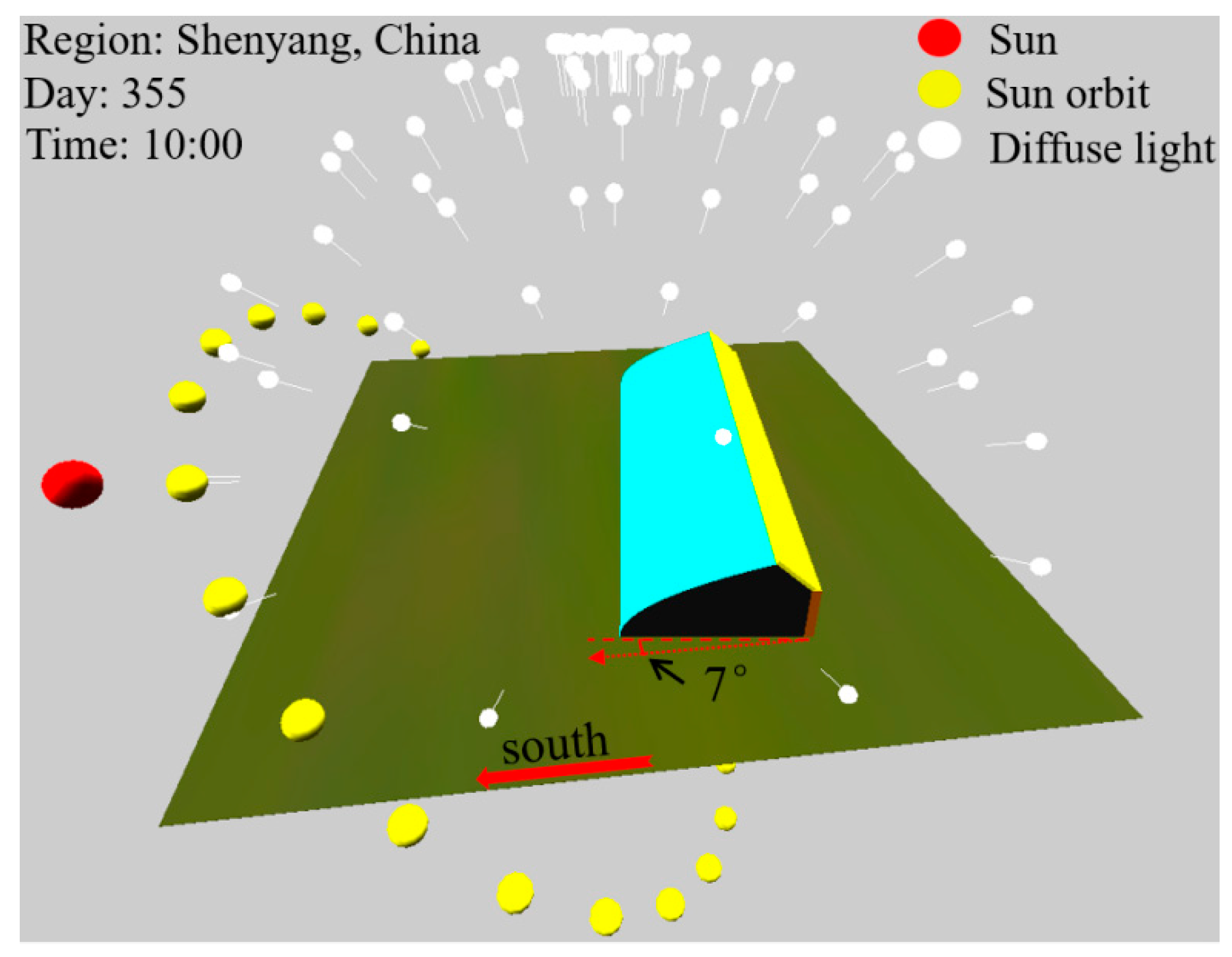
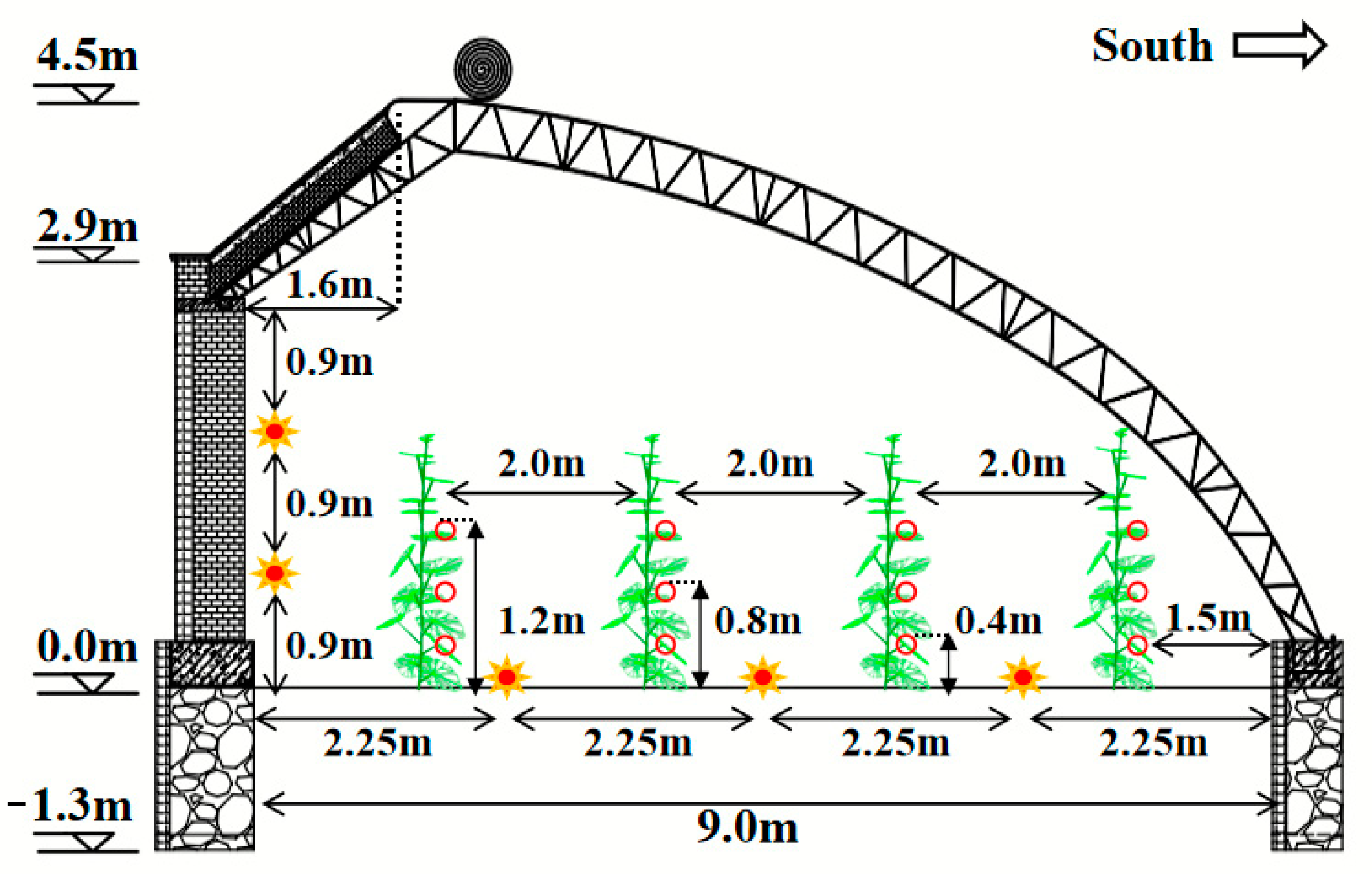

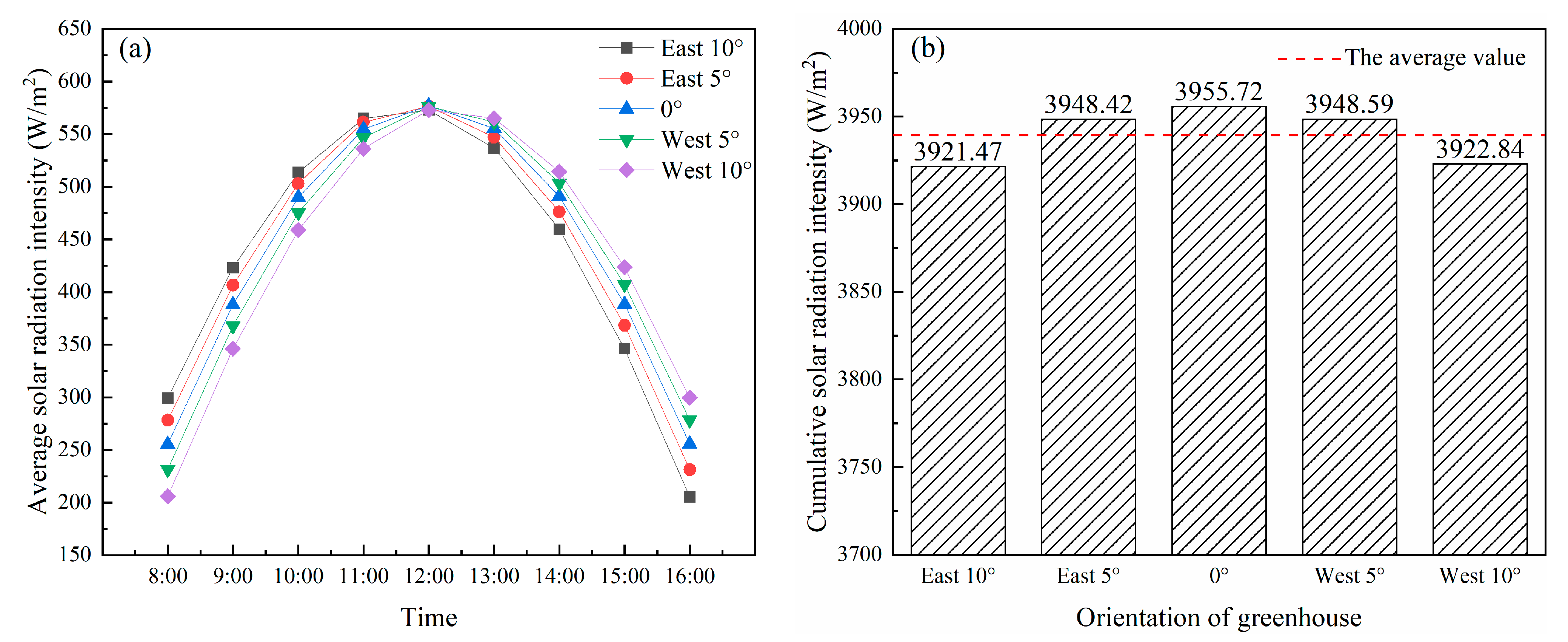
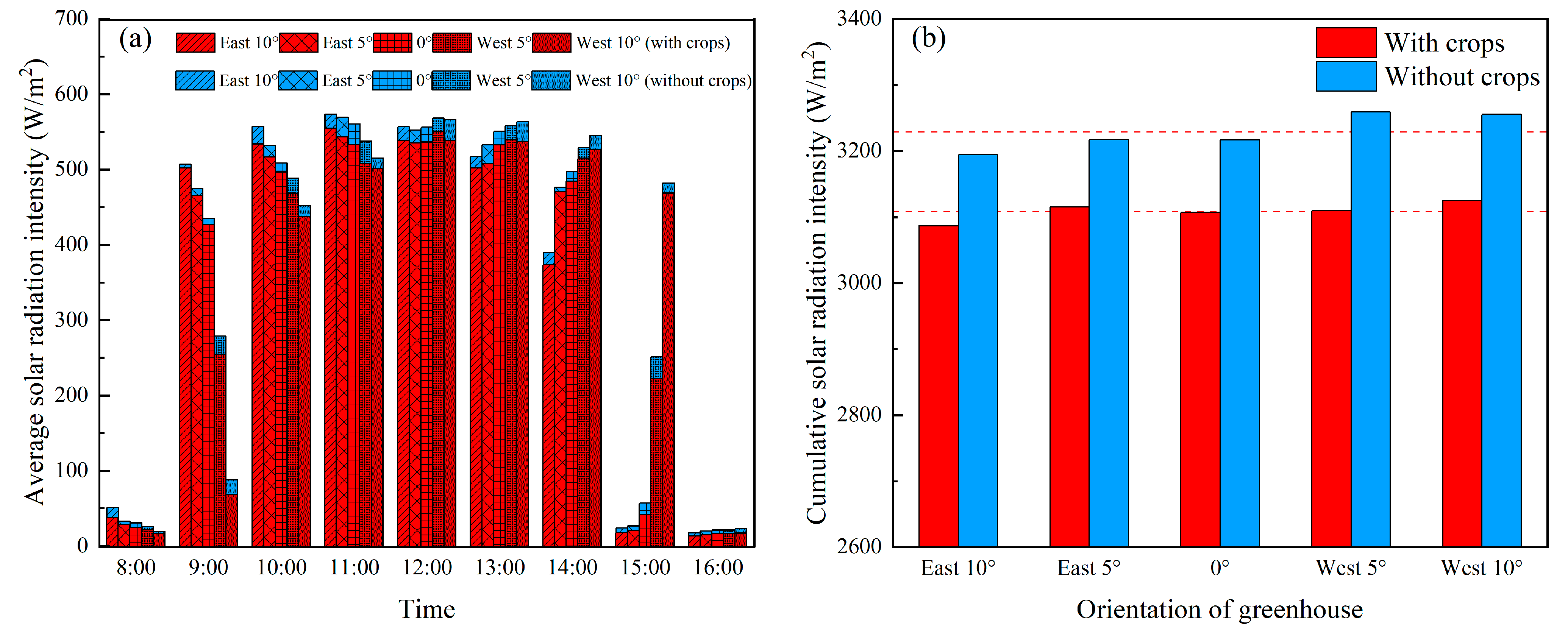

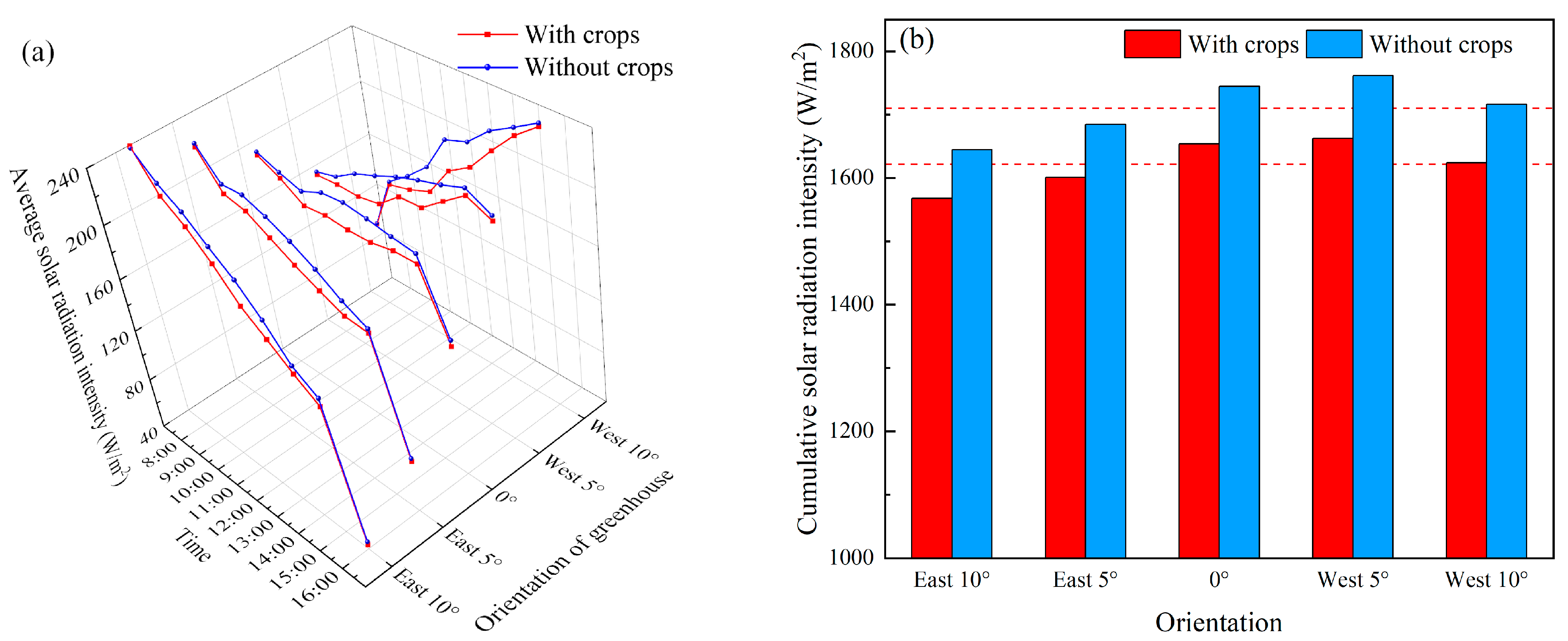
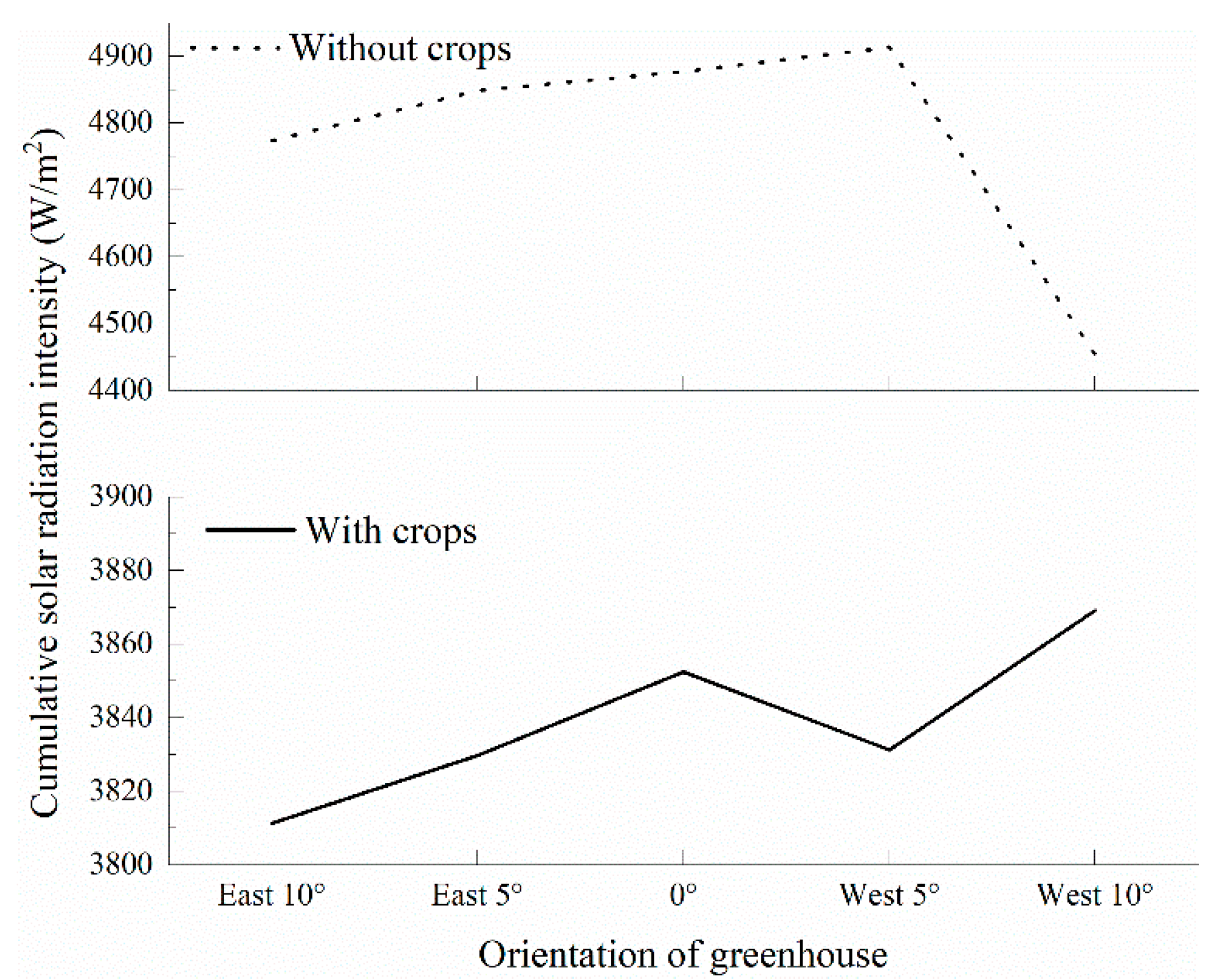


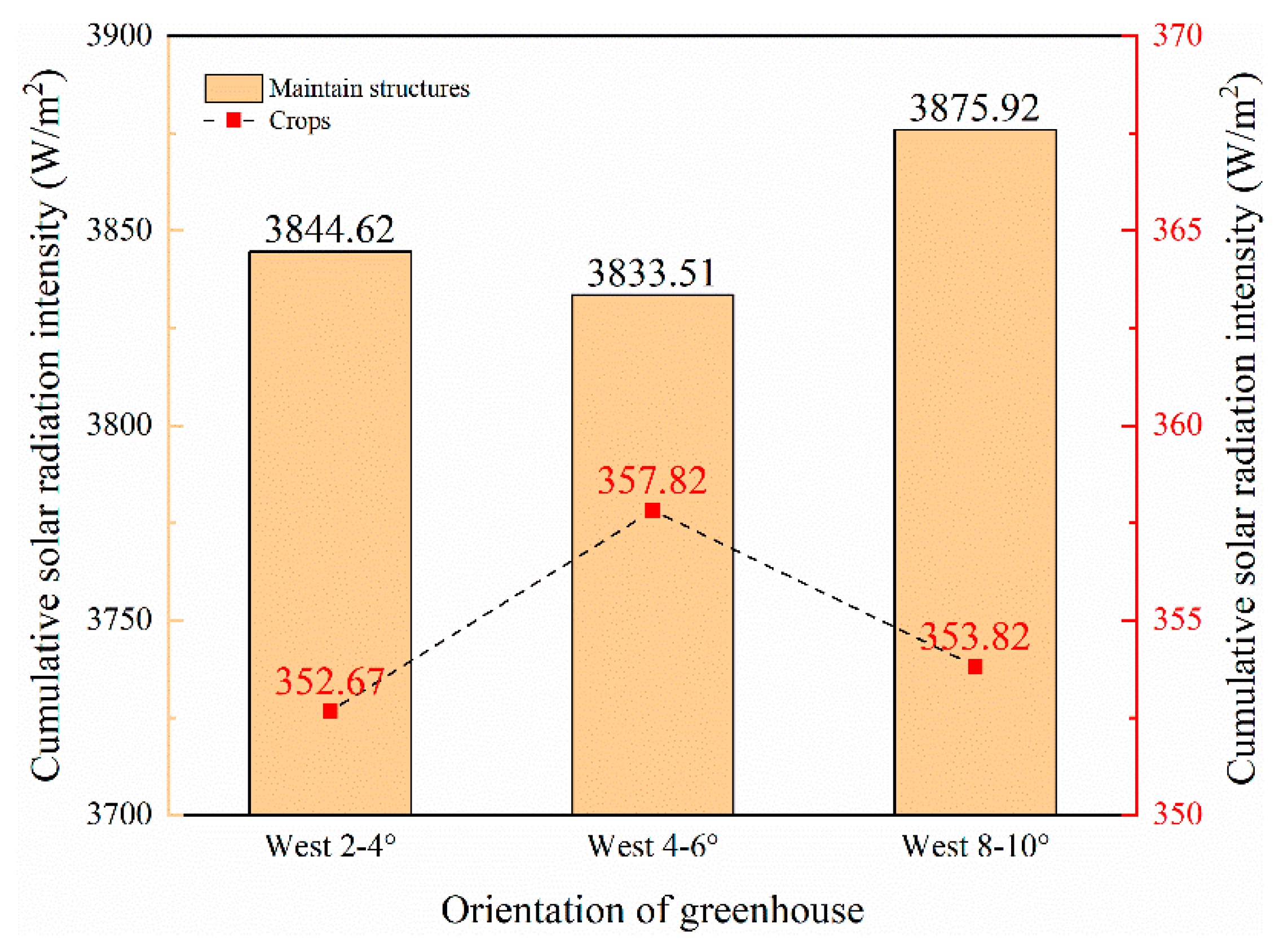
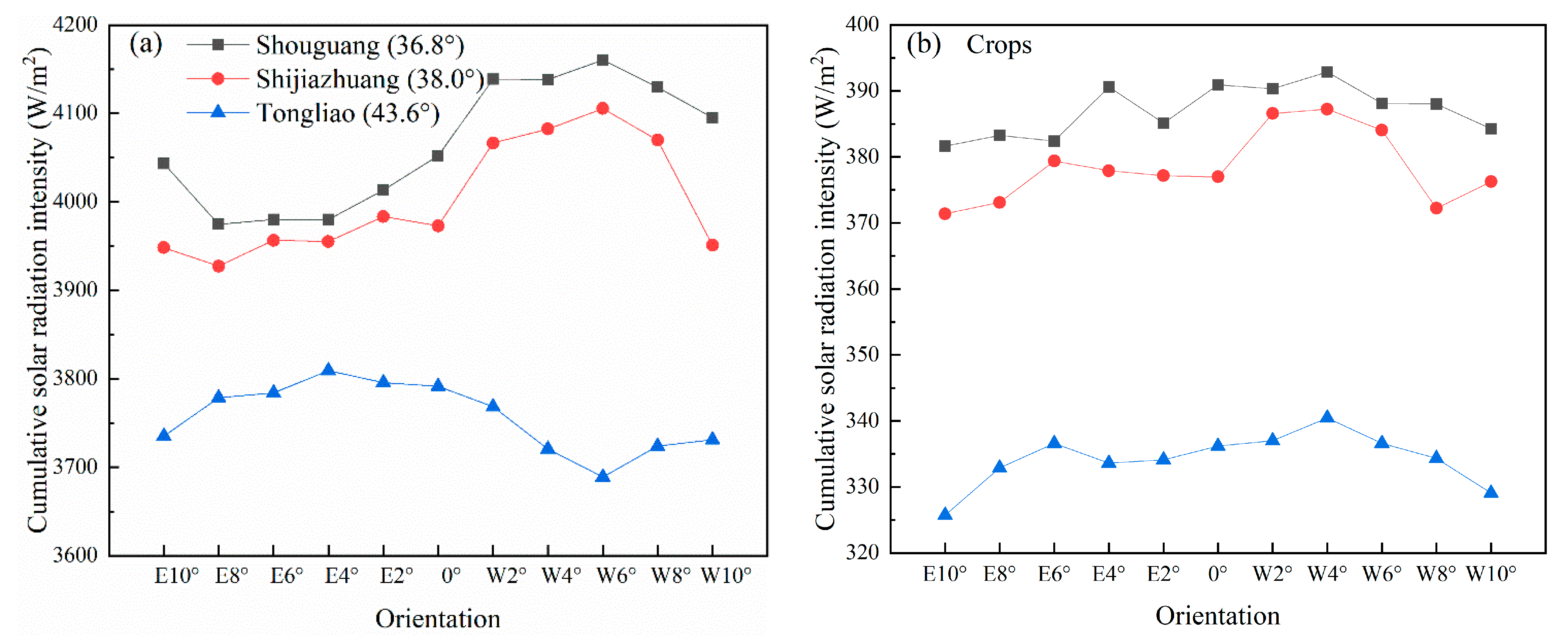
| Description | Value Range | Unit |
|---|---|---|
| Greenhouse size | ||
| Lighting roof (L, W, H) | 60, 9.2, 0.00015 | meter |
| Wall (L, W, H) | 60, 2.9, 0.48 | meter |
| Ground (L, W, H) | 60, 9, 0.5 | meter |
| Roof (L, W, H) | 60, 2.5, 0.3 | meter |
| Plant arrangement | ||
| Width of the plant wide row | 0.9 | meter |
| Width of the plant narrow row | 0.7 | meter |
| Melon plant spacing | 0.4 | meter |
| Number of rows | 74 | - |
| Number of plants per row | 20 | - |
| Melon plant | ||
| Maximal leaf rank per plant | 19 | - |
| Averaged plant height | 1.3 | meter |
| Averaged petiole length per rank | 0.094, 0.075, 0.07, 0.08, 0.14, 0.12, 0.1, 0.1, 0.11, 0.11, 0.11, 0.12, 0.1, 0.1, 0.11, 0.02, 0.02, 0.02, 0.02 | meter |
| Averaged internode length per rank | 0.074, 0.076, 0.056, 0.068, 0.054, 0.063, 0.062, 0.077, 0.056, 0.073, 0.053, 0.08, 0.069, 0.072, 0.083, 0.06, 0.079, 0.082, 0.048 | meter |
| Averaged leaf angle per rank | −20, −26, −25, −18, −21, −24, −10, −6, −33, 28, −18, −26, −14, −10, −23, −28, −28, −34 | ° |
| Averaged petiole angle per rank | 40, 46, 55, 58, 51, 34, 20, 26, 23, 28, 18, 26, 14, 20, 13, 28, 18, 22 | ° |
| Evaluation Index | Empty Greenhouse | Maintain Structures | Crops | ||||||||||
|---|---|---|---|---|---|---|---|---|---|---|---|---|---|
| Area | Azimuth | Structure | Crop | Azimuth | Structure | Rate | Crop | Rate | Azimuth | Structure | Rate | Crop | Rate |
| Shouguang (Φ = 36.8° N) | W 4–6° | 4149.4 | 390.5 | W 4–6° | 4149.4 | 0.00% | 390.5 | 0.00% | W 2–4° | 4138.5 | −0.26% | 391.6 | 0.28% |
| Shijiazhuang (Φ = 38.0° N) | W6–8° | 4087.6 | 378.4 | W 4–6° | 4093.9 | 0.15% | 385.9 | 1.98% | W 2–4° | 4074.4 | −0.32% | 387.6 | 2.43% |
| Shenyang (Φ = 41.8° N) | W 2–4° | 3844.6 | 352.7 | W 8–10° | 3875.9 | 0.81% | 353.8 | 1.14% | W 4–6° | 3833.5 | −0.29% | 357.8 | 1.46% |
| Tongliao (Φ = 43.6° N) | W 8–10° | 3727.4 | 331.7 | E 2–4° | 3802.4 | 2.01% | 333.9 | 0.66% | W 2–4° | 3744.3 | 0.45% | 338.8 | 2.14% |
Publisher’s Note: MDPI stays neutral with regard to jurisdictional claims in published maps and institutional affiliations. |
© 2022 by the authors. Licensee MDPI, Basel, Switzerland. This article is an open access article distributed under the terms and conditions of the Creative Commons Attribution (CC BY) license (https://creativecommons.org/licenses/by/4.0/).
Share and Cite
Liu, A.; Xu, D.; Henke, M.; Zhang, Y.; Li, Y.; Liu, X.; Li, T. Determination of the Optimal Orientation of Chinese Solar Greenhouses Using 3D Light Environment Simulations. Remote Sens. 2022, 14, 912. https://doi.org/10.3390/rs14040912
Liu A, Xu D, Henke M, Zhang Y, Li Y, Liu X, Li T. Determination of the Optimal Orientation of Chinese Solar Greenhouses Using 3D Light Environment Simulations. Remote Sensing. 2022; 14(4):912. https://doi.org/10.3390/rs14040912
Chicago/Turabian StyleLiu, Anhua, Demin Xu, Michael Henke, Yue Zhang, Yiming Li, Xingan Liu, and Tianlai Li. 2022. "Determination of the Optimal Orientation of Chinese Solar Greenhouses Using 3D Light Environment Simulations" Remote Sensing 14, no. 4: 912. https://doi.org/10.3390/rs14040912
APA StyleLiu, A., Xu, D., Henke, M., Zhang, Y., Li, Y., Liu, X., & Li, T. (2022). Determination of the Optimal Orientation of Chinese Solar Greenhouses Using 3D Light Environment Simulations. Remote Sensing, 14(4), 912. https://doi.org/10.3390/rs14040912





